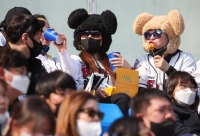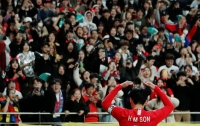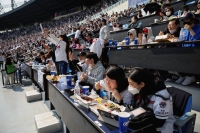Each time the South Korean men’s soccer team scored against Singapore during a recent 5-0 rout in a World Cup qualifier, the roar from the home crowd came largely from women, who held nearly two-thirds of the tickets to the match.
In the Seoul stadium that November day, a billboard-size banner for star striker Son Heung-min had been made by a women-only group. A banner for one of his teammates — "Cho Gue-sung wins the day” — had been signed by a club called "Women Rooting for Cho Gue-sung’s Pursuit of Happiness.”
The scene illustrated a fact that has puzzled experts in one of the world’s most patriarchal societies: In sports, South Korean women generally outnumber men in the stands.
Women here make up 55% of fans at professional sporting events, including baseball, basketball, soccer and volleyball, according to a 2022 estimate by the Korea Professional Sports Association. Similar estimates for major sports in the United States put the figure at less than half for women. In Britain and Australia, that number drops to a quarter or less.
Fans and sports experts attribute South Korea’s high rate of female fandom partly to the sense of security at the country’s sports venues. Others say it’s influenced by a national fan culture powered by intense worship of stars, who are in some cases heartthrobs.
"People don’t think of the players as athletes, but as celebrities,” said Yim Subin, 24, who attends games and fan meetups, and watches baseball on TV every day of the season. "It’s not much different from the way K-pop fans follow their idols.”
In South Korea, where modern sports like baseball and soccer were introduced in the late 19th century, professional leagues were a product of brisk economic growth that began in the 1960s and created a large middle class. The leagues matured in tandem with the hosting of major international competitions, including the 1988 Summer Olympics and the 2002 men’s World Cup.
Women have long been part of a South Korean fan base that considers following sports a national pastime, glorifying elite (and usually male) athletes who compete abroad. In the 1970s, the man of the moment was Cha Bum-kun, who scored 98 goals for two clubs in Germany’s top soccer league. Now the sports idol is Son, a striker for Tottenham Hotspur in the English Premier League.
Female fans have been present at domestic competitions for just as long. In the 1990s, young women packed college basketball stands, said Dae Hee Kwak, an associate professor of sport management at the University of Michigan. He said they were known as "oppa budae,” or armies cheering for male stars they call "oppa,” an affectionate term that Korean women use for an older man.
One explanation for South Korea’s high rate of female fandom is that its arenas are safe places to watch a game. A growing number of venues now offer family-friendly amenities, including children’s playrooms.
In that atmosphere, fighting and other expressions of hooliganism are increasingly rare, said Cho Yijin, a postdoctoral researcher at Yonsei University in Seoul.
"There’s less smoking, drinking and swearing than before,” she said. "There’s a friendlier vibe.”
Another factor, experts say, is the intense domestic fan culture that permeates the country’s entertainment industry.
The meteoric rise of global interest in South Korean films, dramas and music over the past decade or so created a passionate fan base around celebrities whose success is seen as a mark of national pride.
Now the same slang that describes how superfans worship such idols — "deok-jil,” or "fangirling” — is widely used for sports. Fan girls travel across the country to attend games, send coffee trucks to practice as a show of support and snap photos of players with powerful zoom lenses from front-row seats.
The teams’ marketing departments have noticed. There is no shortage of merchandise for women, including jerseys and headbands. And in the country’s top soccer league, the team Daejeon Hana Citizen hosts an amateur "Queen’s Cup” for its female fans.
Eunji Shin, 43, who attends several baseball games a week and takes copious notes on field strategy, once followed her favorite team, the Seoul-based Doosan Bears, to its spring training camp in Japan. She also helped take out a newspaper ad with a thank-you note to a retiring pitcher.
Shin said there was a "lower barrier to entry” for following baseball players than entertainment celebrities for a simple reason: It’s easier to get physically closer to them.
In her experience, the only people who bring cameras to games are women. "Men don’t do that,” she added, "except the few who want to photograph the cheerleaders.”
The rise of women as sports fans in South Korea has not led to gender parity on courts or fields, or in coaching rooms. Sports experts say that is partly because South Korea has no anti-discrimination law, much less legislation like Title IX, the landmark U.S. law from 1972 that significantly expanded girls’ access to sports.
For many female fans, seeing other women in the stands gives them a sense of belonging and solidarity, said NaRi Shin, an assistant professor of sport management at the University of Michigan and a freestyle snowboarder.
Several female fans said that, while male players had been their gateway to sports, they eventually developed a deeper appreciation of the game itself.
Celine Lim, 39, said she started watching Kim Byung-hyun, a South Korean pitcher, play for the Boston Red Sox when she was living in the United States partly because she was drawn to his "bad boy” personality. She kept watching his South Korean team, the Kiwoom Heroes, play almost every game even after he retired.
Han Nagyeong, 26, said her interest in soccer deepened while watching Son play for Tottenham Hotspur. Now, even as a busy university student, she makes time to follow each player on the team. She said she has several friends whose fandom has taken a similar turn.
"Gradually, they became more sincere about the sport itself than anyone else,” she said.
This article originally appeared in The New York Times © 2025 The New York Times Company






















With your current subscription plan you can comment on stories. However, before writing your first comment, please create a display name in the Profile section of your subscriber account page.